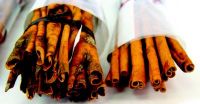(Press-News.org) A "huge" variation exists in the amounts of coumarin in bark samples of cassia cinnamon from trees growing in Indonesia, scientists are reporting in a new study. That natural ingredient in the spice may carry a theoretical risk of causing liver damage in a small number of sensitive people who consume large amounts of cinnamon. The report appears in ACS' bi-weekly Journal of Agricultural and Food Chemistry.
Friederike Woehrlin and colleagues note that cinnamon is the second most popular spice, next to black pepper, in the United States and Europe. Cinnamon, which comes from the bark of trees, is sold as solid sticks and powder with the country of origin rarely declared on the package label. There are two main types: Ceylon cinnamon (also known as "true" cinnamon) and cassia cinnamon. Ceylon grows in Sri Lanka (formerly Ceylon), the Seychelles, and Madagascar. Cassia generally comes from China and Indonesia. Both types can contain coumarin, a natural flavoring found in plants. Studies have linked high coumarin intake to liver damage in a small number of sensitive people.
The scientists analyzed 91 cinnamon samples purchased from stores in Germany. They found that coumarin levels varied widely among different bark samples of Cassia cinnamon. Therefore they analyzed cassia bark samples of five trees received directly from Indonesia and found a huge variation even among samples collected from a single tree. The study confirmed that cassia cinnamon has the highest levels of coumarin, while Ceylon had the lowest levels. On average, cassia cinnamon powder contained up to 63 times more coumarin than Ceylon cinnamon powder and cassia cinnamon sticks contained 18 times more coumarin than Ceylon sticks. "Further research is necessary to identify factors influencing the coumarin levels in cassia cinnamon and to possibly allow the harvesting of cassia cinnamon with low coumarin levels in the future," the report notes.
Health officials say it is almost impossible for consumers to distinguish between Ceylon and cassia in cinnamon powder. Cinnamon sticks, however, do look different. Cassia cinnamon sticks consist of a thick layer of rolled bark, while Ceylon cinnamon sticks have thin layers of bark rolled up into a stick.
INFORMATION:
ARTICLE FOR IMMEDIATE RELEASE
"Quantification of Flavoring Constituents in Cinnamon: High Variation of Coumarin in Cassia Bark from the German Retail Market and in Authentic Samples from Indonesia"
DOWNLOAD FULL TEXT ARTICLE
http://pubs.acs.org/stoken/presspac/presspac/full/10.1021/jf102112p
CONTACT:
Friederike Woehrlin
Federal Institute for Risk Assessment
Berlin, Germany
Phone: 49 (0) 3084122355
Fax: 49 (0) 30184123457
Email: friederike.woehrlin@bfr.bund.de
Levels of coumarin in cassia cinnamon vary greatly even in bark from the same tree
2010-11-04
ELSE PRESS RELEASES FROM THIS DATE:
Small materials poised for big impact in construction
2010-11-04
Bricks, blocks, and steel I-beams — step aside. A new genre of construction materials, made from stuff barely 1/50,000th the width of a human hair, is about to debut in the building of homes, offices, bridges, and other structures. And a new report is highlighting both the potential benefits of these nanomaterials in improving construction materials and the need for guidelines to regulate their use and disposal. The report appears in the monthly journal ACS Nano.
Pedro Alvarez and colleagues note that nanomaterials likely will have a greater impact on the construction ...
Transparent conductive material could lead to power-generating windows
2010-11-04
UPTON, NY - Scientists at the U.S. Department of Energy's (DOE) Brookhaven National Laboratory and Los Alamos National Laboratory have fabricated transparent thin films capable of absorbing light and generating electric charge over a relatively large area. The material, described in the journal Chemistry of Materials, could be used to develop transparent solar panels or even windows that absorb solar energy to generate electricity.
The material consists of a semiconducting polymer doped with carbon-rich fullerenes. Under carefully controlled conditions, the material self-assembles ...
Video-game technology may speed development of new drugs
2010-11-04
Parents may frown upon video games, but the technology used in the wildly popular games is quietly fostering a revolution in speeding the development of new products and potentially life-saving drugs. That's the topic of an article in the current issue of Chemical & Engineering News (C&EN), ACS' weekly newsmagazine.
C&EN Associate Editor Lauren K. Wolf notes that consumer demand for life-like avatars and interactive scenery has pushed computer firms to develop inexpensive yet sophisticated graphics hardware called graphics processing units, or GPUs. The graphical units ...
PET scans reveal estrogen-producing hotspots in human brain
2010-11-04
UPTON, NY - A study at the U.S. Department of Energy's (DOE) Brookhaven National Laboratory has demonstrated that a molecule "tagged" with a radioactive form of carbon can be used to image aromatase, an enzyme responsible for the production of estrogen, in the human brain. The research, published in the November issue of Synapse, also uncovered that the regions of the brain where aromatase is concentrated may be unique to humans.
"The original purpose of the study was to expand our use of this radiotracer, N-methyl-11C vorozole," said Anat Biegon, a Brookhaven neurobiologist. ...
Scientists develop method to keep surgically-removed prostate tissue alive and 'working' for week
2010-11-04
Scientists at the Johns Hopkins Kimmel Cancer Center, University of Helsinki and Stanford University have developed a technique to keep normal and cancerous prostate tissue removed during surgery alive and functioning normally in the laboratory for up to a week.
The new technique could not only enhance research of prostate biology and cancer, but also hasten the creation of individualized medicines for prostate cancer patients, the investigators say. Previous attempts to culture live prostate tissues resulted in poor viability and lost "tissue architecture," the researchers ...
Rice U. study looks at marketing benefits, pitfalls of customer-satisfaction surveys
2010-11-04
Though designed to enhance customer experiences, post-service customer surveys might actually harm a business's relationships with consumers, according to new research by Rice University professors. The research team found that customers who participate in firm-sponsored surveys delay doing repeat business with that company.
The study finds companies that use immediate follow-up customer surveys or multiple follow-up surveys may open themselves to negative consequences because customers who were satisfied with the specific service they received may jump to the conclusion ...
Multifocal contact lenses may reduce vision for night driving
2010-11-04
A new study suggests that older adults who wear multifocal contact lenses to correct problems with near vision, a very common condition that increases with age, may have greater difficulty driving at night than their counterparts who wear glasses. Age-related problems with near vision, medically termed presbyopia, usually occurs after the age of 40 and results in the inability to focus on objects up close.
According to an article published in Investigative Ophthalmology & Visual Science ("The Effect of Presbyopic Vision Corrections on Nighttime Driving Performance"), ...
University of Illinois researchers discover potential new virus in switchgrass
2010-11-04
University of Illinois researchers have confirmed the first report of a potential new virus belonging to the genus Marafivirus in switchgrass, a biomass crop being evaluated for commercial cellulosic ethanol production.
The virus is associated with mosaic and yellow streak symptoms on switchgrass leaves. This virus has the potential of reducing photosynthesis and decreasing biomass yield. Members of this genus have been known to cause severe yield losses in other crops. For example, Maize rayado fino virus (MRFV), a type member of the genus, has been reported to cause ...
Physics experiment finds violation of matter/antimatter symmetry
2010-11-04
ANN ARBOR, Mich.---The results of a high-profile Fermilab physics experiment involving a University of Michigan professor appear to confirm strange 20-year-old findings that poke holes in the standard model, suggesting the existence of a new elementary particle: a fourth flavor of neutrino.
The new results go further to describe a violation of a fundamental symmetry of the universe asserting that particles of antimatter behave in the same way as their matter counterparts.
Neutrinos are neutral elementary particles born in the radioactive decay of other particles. The ...
Yale journal explores new environmental applications of ICT
2010-11-04
New Haven, Conn. -- New applications of information and communication technology (ICT) that could save society significant amounts of energy and money and reduce greenhouse gas emissions that are warming the planet are explored in a special issue of Yale's Journal of Industrial Ecology.
These applications exploit recent advances in ICT, such as social networking and Web 2.0, smart energy monitoring and geographic information systems, and are explored in depth in the special issue "Environmental Applications of ICT," published with support from the Leading Edge Forum ...


